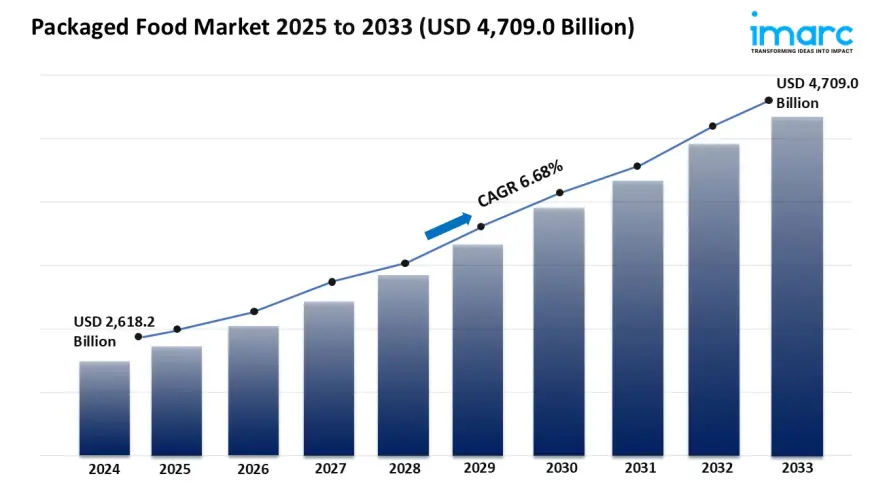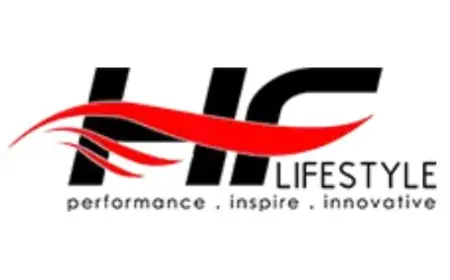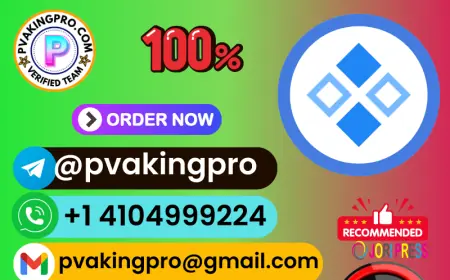Packaged Food Industry Size, Growth & Forecast 2025-2033
The global packaged food market size reached USD 2,618.2 Billion in 2024. Looking forward, IMARC Group expects the market to reach USD 4,709.0 Billion by 2033, exhibiting a growth rate (CAGR) of 6.68% during 2025-2033.

Market Overview:
The packaged food market is experiencing rapid growth, driven by rising demand for convenience foods, growing health-conscious consumer base, and advancements in packaging technology. According to IMARC Group's latest research publication, "Packaged Food Market Report by Product Type (Bakery Products, Dairy Products, Beverages, Breakfast Products, Meals, and Others), Distribution Channel (Supermarket/Hypermarket, Specialty Stores, Convenience Stores, Online Retail Stores, and Others), and Region 2025-2033", the global packaged food market size reached USD 2,618.2 Billion in 2024. Looking forward, IMARC Group expects the market to reach USD 4,709.0 Billion by 2033, exhibiting a growth rate (CAGR) of 6.68% during 2025-2033.
This detailed analysis primarily encompasses industry size, business trends, market share, key growth factors, and regional forecasts. The report offers a comprehensive overview and integrates research findings, market assessments, and data from different sources. It also includes pivotal market dynamics like drivers and challenges, while also highlighting growth opportunities, financial insights, technological improvements, emerging trends, and innovations. Besides this, the report provides regional market evaluation, along with a competitive landscape analysis.
Download a sample PDF of this report: https://www.imarcgroup.com/packaged-food-market/requestsample
Our report includes:
- Market Dynamics
- Market Trends and Market Outlook
- Competitive Analysis
- Industry Segmentation
- Strategic Recommendations
Growth Factors in the Packaged Food Market
- Rising Demand for Convenience Foods
The packaged food industry is booming because people want quick, easy meals that fit their busy lives. With more folks working long hours or juggling multiple responsibilities, ready-to-eat meals, frozen dinners, and pre-packaged snacks are lifesavers. For instance, a recent survey showed that 60% of U.S. consumers buy convenience foods weekly, driving sales of packaged goods like microwaveable meals and snack bars. Companies like Nestlé have leaned into this, launching new lines of frozen meals tailored for single-serve portions. Improved retail infrastructure, like Amazon’s grocery delivery, makes these products even more accessible. Government schemes, such as India’s PM FME Scheme, support small businesses in producing convenient packaged foods, boosting local markets. This demand for hassle-free options keeps pushing the packaged food industry forward.
- Growing Health-Conscious Consumer Base
Health awareness is reshaping the packaged food industry as more people seek nutritious options. Consumers are gravitating toward products with clean labels, low sugar, or added functional ingredients like protein or fiber. A study found that 70% of global shoppers check nutrition labels before buying packaged foods. Brands like General Mills are responding with organic cereal lines and low-sodium snacks. Government initiatives, such as the UK’s stricter food labeling regulations, encourage transparency, further fueling this trend. The rise in dietary restrictions, like lactose intolerance, has also spiked demand for specialized products—lactose-free items now hold a 35% share in the food intolerance market. This health-focused shift is a key driver in packaged food industry analysis, as companies innovate to meet these evolving preferences.
- Advancements in Packaging Technology
Innovative packaging is a game-changer for the packaged food industry, enhancing shelf life, safety, and appeal. Technologies like antimicrobial coatings and multi-layered films are making food safer and fresher for longer. For example, 40% of baby food packaging now uses tamper-proof, eco-friendly materials, driven by consumer demand for safety. Companies like Amcor are investing heavily in sustainable packaging, with new biodegradable options hitting the market. Government regulations, like bans on single-use plastics in the EU, are pushing brands to adopt greener solutions. These advancements not only meet consumer expectations but also reduce waste, aligning with global sustainability goals. Packaged food industry analysis highlights how these packaging innovations are critical for market growth, as they balance functionality with environmental responsibility.
Key Trends in the Packaged Food Market
- Surge in Sustainable Packaging
Sustainability is a hot topic in the packaged food industry, with consumers and governments pushing for eco-friendly solutions. Shoppers are demanding less plastic and more recyclable or biodegradable packaging—40% of snack food packaging now uses paperboard or bioplastics. Companies like Tetra Pak are rolling out plant-based cartons, reducing carbon footprints. In Germany, consumer awareness has led to a 20% increase in sustainable packaging adoption. Government policies, like the EU’s single-use plastic ban, are forcing brands to innovate. Packaged food industry analysis shows this trend isn’t just about ethics; it’s also a business win, as sustainable packaging boosts brand loyalty among eco-conscious consumers. Expect more companies to invest in green solutions to stay competitive in this evolving market.
- Rise of Plant-Based and Alternative Proteins
The packaged food industry is seeing a huge shift toward plant-based and alternative protein products as consumers embrace healthier, sustainable diets. About 30% of global consumers now identify as flexitarian, cutting back on meat. Brands like Beyond Meat are launching plant-based snacks, while Kraft Heinz has introduced vegan cheese slices. The ethnic food market, including plant-based Indian and Thai options, is growing, with 70% of U.S. consumers trying international cuisines. Government support, like subsidies for organic farming in the U.S., is helping scale production. Packaged food industry analysis points to this trend as a major growth driver, with plant-based packaged foods gaining shelf space in supermarkets and appealing to health-conscious and environmentally aware shoppers.
- Growth of E-Commerce and Food Delivery
The rise of online food delivery and e-commerce is transforming the packaged food industry. Platforms like Uber Eats and DoorDash have increased demand for sturdy, leak-proof packaging, with 50% of foodservice packaging now designed for delivery. Companies like Mondelez are partnering with digital platforms to sell snack packs directly to consumers. In Asia-Pacific, e-commerce accounts for 45% of packaged food sales, driven by urbanization in China and India. Government schemes, like India’s digital retail incentives, are boosting online grocery access. Packaged food industry analysis highlights how this trend is reshaping supply chains, with brands optimizing packaging for transit and investing in digital marketing to capture online shoppers, making convenience and accessibility key to staying competitive.
Leading Companies Operating in the Packaged Food Industry:

- Conagra Brands Inc.
- Danone S.A.
- General Mills Inc.
- Hormel Foods Corporation
- JBS S.A.
- Kellogg Company
- Maple Leaf Foods Inc
- Nestlé S.A
- PepsiCo Inc.
- The Coca-Cola Company
- The Kraft Heinz Company
- Tyson Foods Inc.
- WH Group Limited
Packaged Food Market Report Segmentation:
By Product Type:
- Bakery Products
- Dairy Products
- Beverages
- Breakfast Products
- Meals
- Others
The packaged food market includes bakery products, dairy products, beverages, breakfast products, meals, and others, with bakery products holding the largest market share due to their popularity and versatility.
By Distribution Channel:

- Supermarket/Hypermarket
- Specialty Stores
- Convenience Stores
- Online Retail Stores
- Others
The market is segmented into supermarkets/hypermarkets, specialty stores, convenience stores, online retail stores, and others, with supermarkets/hypermarkets accounting for the largest share, driven by their convenience, competitive pricing, and extensive reach.
Regional Insights:
- North America (United States, Canada)
- Asia Pacific (China, Japan, India, South Korea, Australia, Indonesia, Others)
- Europe (Germany, France, United Kingdom, Italy, Spain, Russia, Others)
- Latin America (Brazil, Mexico, Others)
- Middle East and Africa
The packaged food market analysis covers regions such as North America, Asia-Pacific, Europe, Latin America, and the Middle East and Africa, with Asia Pacific exhibiting clear dominance in the market.
Research Methodology:
The report employs a comprehensive research methodology, combining primary and secondary data sources to validate findings. It includes market assessments, surveys, expert opinions, and data triangulation techniques to ensure accuracy and reliability.
Note: If you require specific details, data, or insights that are not currently included in the scope of this report, we are happy to accommodate your request. As part of our customization service, we will gather and provide the additional information you need, tailored to your specific requirements. Please let us know your exact needs, and we will ensure the report is updated accordingly to meet your expectations.
About Us:
IMARC Group is a global management consulting firm that helps the world’s most ambitious changemakers to create a lasting impact. The company provide a comprehensive suite of market entry and expansion services. IMARC offerings include thorough market assessment, feasibility studies, company incorporation assistance, factory setup support, regulatory approvals and licensing navigation, branding, marketing and sales strategies, competitive landscape and benchmarking analyses, pricing and cost research, and procurement research.
Contact Us:
IMARC Group
134 N 4th St. Brooklyn, NY 11249, USA
Email: [email protected]
Tel No:(D) +91 120 433 0800
United States: +1-631-791-1145
What's Your Reaction?
 Like
0
Like
0
 Dislike
0
Dislike
0
 Love
0
Love
0
 Funny
0
Funny
0
 Angry
0
Angry
0
 Sad
0
Sad
0
 Wow
0
Wow
0




















































